Wstęp: Szukając dialogu (Marek Pąkciński)
The present edition of the journal is a bilingual publication. Its title, Not Only Poem, Not Only the Novel – Polish and Russian Literature in the Context of Literary Genres, conveys the intentions of the Editorial Office – in this edition, we wanted to move away from traditional research on the literary and cultural relations through the prism of ‘images’ and ‘stereotypes’, concentrating instead on the mutual inspirations (historic and contemporary), as well as on jointly accomplished academic projects by Polonists, Slavists and Russicists on the topics relating to literature studies, textology, translation, editing and cultural studies.
Texts published in the XXIV series of Napis often present a comparative perspective – this is the case in the article on the relationships between Samuel Bogumił Linde and Faddei (Thaddeus) Bulgarin, in the work devoted to the writings of Zygmunt Krzyżanowski, a Russian writer from a Polish background (which depicts parallels with the works of Franz Kafka as a representative of ‘minor literatures’), or in the publication on the topic of the ancient and Russian inspirations in the later poetic works of Adam Mickiewicz (as the long poem ‘Królewna Lala’ [‘The Princess Doll’] draws upon both the ancient Roman writer, Apuleius, and the eighteenth-century poet and dramatist, Ippolit Fyodorovich Bogdanovich). The edition is undoubtedly haunted by the figure of Fyodor Dostoevsky, whose work is explored in three articles, touching on a diverse range of topics (the place of the writer in Polish post-war humanities; calligraphic handwriting of Dostoevsky in manuscripts as a source of knowledge on the mechanisms of the author’s work and on the origin of the complexity of meaning in his novels; minor forms of folklore in the narration of Dostoevsky’s texts).
The genological theme proposed in the title of the edition is also expressed in the publications devoted to Gulag literature, in which a special place is reserved for The Kolyma Tales by Varlam Shalamov. In the editorial section, we offer not only an interesting discussion of new tools and digital publishing projects (‘Textograph’ and the editing of a novel by Leo Tolstoy), but also, inter alia, articles illustrating the issue of censorship, which is still alive in the reception of various texts from the Polish-Russian cultural borderlines. These range from the Enlightenment-era tragic opera, Polusia…, by the, now forgotten, ‘meagre poet’ Wincent Marewicz, and its Russian translation, through to the interference of tsarist officials into the theatrical adaptation of Quo Vadis by Henryk Sienkiewicz, Witold Woroszylski’s misadventures with the censorship during his long-time translation career, and the comparison of two Polish versions of the translation of a science-fiction novel by the Strugatsky brothers. The reader can also find publications relating to wider cultural themes, such as the reception of the accomplishments of Soviet theatre in interwar Poland, or the depiction of the Soviet Union and its inhabitants from the same period, regarded by Polish travellers from the very specific perspective of attire. It is worth noting that the essays presented in the tome make use of source texts and genres belonging to the field of occasional and applied literature as research material – such as reportage, letter, or theatre review.
The review and report section contains up-to-date discussions and commentaries on important events, such as the conference devoted to the 250th anniversary of the Bar Confederation, or the summing-up of the final years of work of the, now unfortunately defunct, Polish Academy of Sciences Station in Moscow.
The aim of the creators of the most recent volume of Napis was to illustrate, at least fragmentarily, the diversity of research methods and traditions, mutual inspirations relating to the literature of both cultures and languages, as well as common challenges and opportunities presented to humanities’ researchers by the Polish-Russian cooperation.
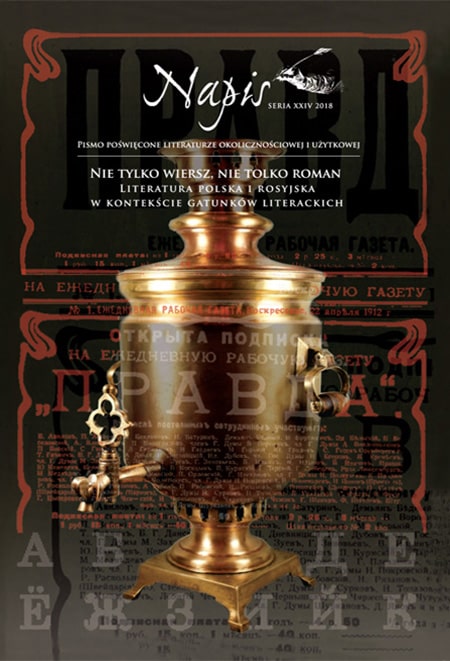
Wstęp: Szukając dialogu (Marek Pąkciński)
Magdalena DĄBROWSKA
Samuel Bogumił Linde i Tadeusz Bułharyn – wokół polskiego przekładu „Rysu historycznego literatury rosyjskiej” Nikołaja Grecza
Artykuł (PDF) Show abstract Hide abstract Показать изложение текста Скрыть изложение текста
The paper concerns the reception of Russian literature in Poland and the opinions on it in Russia in the first half of the nineteenth century. It consists of two parts: firstly, the presentation of Thaddeus Bulgarin’s essay on Russian publications in 1822, in the structure of the Polish edition of the Historical outline of Russian literature by Nikolay Gretsch (edited and translated by S.B. Linde, Warsaw 1823, annex No. VII b); secondly, the presentation of Bulgarin’s review of the Polish edition of the Historical outline of Russian literature by Gretch (‘Severnyi Arkhiv’ 1823, No. 18). The interpretative context is the correspondence between Linde and Vasily Anastasevich.
Магдалена Домбровская
Статья относится к сфере исследования научных и литературных связей между поляками и представителями русской культуры польского происхождения первой половины XIX века. Материалом для изучения взаимоотношений Самуила Богумила Линде (1771-1847), лексикографа, переводчика и библиотекаря, и Фаддея (Яна Тадеуша) Булгарина (1789-1859), прозаика, журналиста, издателя популярной газеты «Северная пчела», послужили: 1. корреспонденция Линде с Василием Анастасевичем 1822-1830 гг. (ред. М. Пташик, Торунь, 2013); 2. Rys historyczny literatury rosyjskiej (Опыт краткой истории русской литературы) Николая Греча (Варшава, 1823), изданный в переводе и под редакцией Линде со статьей Булгарина Краткое обозрение русской литературы 1822 года в качестве одного из приложений. Упоминания о Булгарине в корреспонденции Линде проанализированы в трех аспектах: истории и содержания «Литературной газеты и Северного архива», булгариновской публицистики (статья о Марине Мнишек) и его романного творчества (Иван Выжигин). «Приложение» Булгарина к польскому изданию Греча рассматривается в структуре целого публикации и с точки зрения комментариев Линде. Интерпретационным фоном послужили, в частности, автобиография Линде и воспоминания Ивана Лобойко.
Ewa SZCZEGLACKA-PAWŁOWSKA
Barwa komiczna [„Królewny Lali”] Adama Mickiewicza. Od baśni Apulejusza z Madaury o Amorze i Psyche do „Duszeńki” Ippolita F. Bogdanowicza
Artykuł (PDF) Show abstract Hide abstract Показать изложение текста Скрыть изложение текста
The article is an interpretative study devoted to [Królewna Lala] [The Princess Doll] by Adam Mickiewicz, in light of the comic poem convention. It is an attempt at identifying and developing the lines of interpretation which already exist in the research dedicated to the text, initiated by Tadeusz Sinko. The scholar devoted much attention to the unfinished long poem by Mickiewicz. Sinko called [Królewna Lala] a fairy-tale and proposed (having supported it with source text analyses) that the long poem contained motifs and subplots for which the most likely inspiration was the story of Cupid and Psyche by Apuleius Madaurensis (Metamorphoses, chapter IV 28-VI 24). Ewa Szczeglacka-Pawłowska leads her research towards an analysis of [Królewna Lala] in relation to the genre characteristics of the comic poem, especially Dushenka by Ippolit Fyodorovich Bogdanovich, a creative travesty of the Apuleius’s tale, which was very well-known in the Romantic period, as well as the rococo long poem by Jean de La Fontaine, entitled Les amours de Psyché et de Cupidon.
Эва Щегляцкая-Павловская
Статья посвящена интерпретации [Царевны Ляли] Адама Мицкевича в свете конвенции комической поэмы. В ней предпринята попытка поиска новых и развития уже существующих исследовательских направлений интерпретации, заложенных Тадеушем Синко. Ученый уделил много внимания неоконченной поэме Мицкевича. Синко назвал [Царевну Лялю] сказкой и утверждал (на основе анализа текстовых источников), что в поэме есть сюжеты и линии, наиболее правдоподобным источником которых является Сказка об Амуре и Психее Апулея (Метаморфозы, IV 28–VI 24). Автор анализирует [Царевну Лялю] в жанровом контексте комической поэмы, в частности, Душеньки Ипполита Федоровича Богдановича, произведения в духе очень распространенного в эпоху романтизма творческого травести сказки Апулея и поэмы в стиле рококо Жана де Лафонтена Les amours de Psyché et de Cupidon.
Анастасия ВЕКШИНА
Между книжностью и разговорностью: малые фольклорные жанры в структуре метариторической рефлексии Достоевского
Artykuł (PDF) Show abstract Hide abstract Pokaż abstrakt Ukryj abstrakt
Anastazja Wiekszyna
The article presents an analysis of small forms of folklore (proverbs, sayings) in the structure of meta-rhetorical and meta-stylistic reflection of characters and narrators of F. Dostoevsky. It demonstrates the way in which Dostoevsky makes use of genre schemata, as well as words accepted in written and spoken language, transforming proverbs and giving them a new meaning depending on the context, as well as developing them within the framework of the plot (a proverb becomes the origin of an event in a novel or short story). The author of the article describes the mechanisms or re-interpretation, ostranenie (defamiliarization), theatralisation, and irony, built on the basis of a certain deconstruction of fixed stylistic forms, which operate in written and spoken language. Using these ‘minor’ processes of linguistic transformation as an example, the article allows one to trace the general poetics strategy of the writer. The strategy is directed towards a renewal of literary language through, among other things, a confrontation with language that is colloquial, contemporary, devoid of ‘dead’ literary phraseology, and drawing from the wealth of creative folk imagination.
Anastazja Wiekszyna
Artykuł przedstawia analizę małych form folkloru (przysłowia, powiedzenia) w strukturze refleksji metaretorycznej i metastylistycznej bohaterów i narratorów F. Dostojewskiego. Pokazuje, w jaki sposób pisarz korzysta ze schematów gatunkowych i wyrazów przyjętych w języku pisanym oraz mówionym, transformując przysłowia, nadając im nowy sens w zależności od kontekstu, rozwijając je w ramach fabuły (przysłowie staje się źródłem wydarzenia powieści czy opowiadania). Autorka opisuje mechanizmy reinterpretacji, ostranienija, teatralizacji, ironii, zbudowane na podstawie swoistej dekonstrukcji stałych form stylistycznych, funkcjonujących w języku pisanym i mówionym. Na przykładzie tych „drobnych” procesów transformacji językowej artykuł pozwala śledzić ogólną strategię poetyki pisarza, skierowaną w stronę odnowy języka literackiego m.in. poprzez konfrontację właśnie z językiem potocznym, współczesnym, pozbawionym „martwej” frazeologii literackiej, korzystającym z pokładów twórczej wyobraźni ludowej.
Tadeusz SUCHARSKI
Dostojewski w polskiej powojennej refleksji humanistycznej
Artykuł (PDF) Show abstract Hide abstract Показать изложение текста Скрыть изложение текста
The present outline is an attempt at compiling the experiences and attainments of the Polish post-war reflection on the work of Fyodor Dostoevsky. The Russian genius was probably the only author who inspired both Polish researchers and writers alike. In the article, the author argues that interest was sparked both by the life of The Brothers Karamazov’s author, and by his work, which, moreover, was often read in a biographical context. The Polish dostoevskology was developing in two strands: the émigré one, free from the pressures of censorship, and the domestic one which was subject to significant censorial restrictions up until 1989. Despite the hindrances in the years 1956 to 1989, there emerged many works which made an important contribution not only to Russian studies in Poland, but also to the global contemplation on Dostoevsky’s work. Since the beginning of the 1990s, a remarkable development of Polish dostoevskology has been taking place; ideology ceased to restrict researchers, and many studies of surprisingly differing methodologies have been conducted.
The article discusses the vast majority of Polish books devoted to the work, philosophy and philosophy of history of the author of Demons (the most important articles are also mentioned). What is more, the dynamics of dostoevskology are presented, together with its diversity of topics (studies on novel poetics originating from Bakhtin’s concepts, issues of anthropology, religion, philosophy of history, ethics, the aesthetic and ideological influence of Dostoevsky on Polish and world literature). Also explored is its methodological diversity: from biographism, to Marxism, structuralism, semiotics, hermeneutics and the history of ideas. The works were very often interdisciplinary in nature. This review allowed the author to conclude that the significance of Polish research on the work of the Russian writer is defined as a symbiotic coupling of a particular ‘Polish outlook’ and a uni- versal perspective.
Тадеуш Сухарский
Статья представляет собой попытку подытожить опыт и достижения послевоенной польской рефлексии над творчеством Федора Достоевского. Русский гений был, наверное, единственным художником, который равно вдохновлял как польских ученых, так и польских писателей. В статье доказывается, что интерес вызывали как жизнь автора Братьев Карамазовых, так и его творчество, часто, впрочем, тоже в контексте биографии. Польское достоеведение развивалось в двух течениях: эмигрантском, свободном от давления цензуры, и внутри страны, до 1989 г. имевшем существенные цензурные ограничения. Несмотря на это, в 19561989 гг. было написано много работ, внесших существенный вклад не только в польскую, но и в мировую русистику. На начало 90х годов пришелся бум польского достоеведения, идеология перестала ограничивать исследователей, было создано множество методологически удивительно разнообразных трудов.
В статье рассматривается подавляющее большинство польских книг, посвященных творчеству, философии и историософии автора Бесов, упомянуты также важнейшие статьи. Показана динамика рефлексии над Достоевским, ее проблемное разнообразие (исследования по поэтике романа, берущие начало в концепции Бахтина, вопросы антропологии, религии, историософии, этики, эстетического и мировоззренческого влияния Достоевского на польскую и мировую литературу) и методологические направления: от биографического подхода, марксизма, структурализма, семиотики, герменевтики до истории идей. Часто работы носили междисциплинарный характер. Настоящий обзор позволил прийти к выводу, что значение польских исследований Достоевского состоит в соединении специфически «польского» взгляда с универсальной перспективой.
Paweł ŁANIEWSKI
Zygmunt Krzyżanowski w kontekście literatury mniejszej – zarys problematyki badawczej
Artykuł (PDF) Show abstract Hide abstract Показать изложение текста Скрыть изложение текста
The trend of minor literatures, defined by Gilles Deleuze and Félix Guattari, took up a special place in contemporary literary research. The particular social status of the creator determines within them a wide range of modifications to the fabrics of language, poetics and composition. It is also responsible for the development of a unique philosophical background, adapted to representing the voice of the minority. From the researchers’ point of view, Franz Kafka became the model writer of this movement: a Jew from Prague, writing in German. The author of the article presents an outline of research into the aspects of minor-ness in the work of Zygmunt Krzyżanowski – a Russian writer with a Polish background, one of the most interesting representatives of post-symbolism, whose writings, for political reasons, were only discovered at the time of the perestroika. The issues discussed (Krzyżanowski’s social status, his strategy of constructing descriptions of space, the role of sound in his artistic vision) constitute an introduction to further studies on minority poetics and philosophical concepts present in his prose.
Павел Ланевский
Понятие малых литератур, сформулированное Жилем Делезом и Феликсом Гват тари, занимает особенное место в современном литературоведении. Социаль ная специфика авторской позиции предопределяет широкий спектр вариантов модификаций языка, поэтики и композиции, а также отвечает за формирование уникального философского фона, приспособленного для высказывания меньшин ства. По мнению ученых, идеальным примером этого течения в литературе стал Франц Кафка – пражский еврей, писавший на немецком языке. Автор статьи очер чивает проблематику исследований темы меньшинства в творчестве Сигизмунда Кржижановского – русского писателя польского происхождения, одного из самых интересных представителей постсимволизма, наследие которого по политическим причинам известно стало только во время перестройки. Рассматриваемые вопросы (общественная позиция Кржижановского, стратегия конструирования описаний пространства, роль звука в его художественном мире) являются вступлением к даль нейшим исследованием поэтики малой литературы и философских концепций в прозе писателя.
Wiktoria MOCZAŁOWA
Ilja Erenburg i Dmitrij Fiłosofow: dwa spojrzenia na Polskę okresu międzywojennego
Artykuł (PDF) Errata (PDF) Show abstract Hide abstract Показать изложение текста Скрыть изложение текста
The article presents an attempt at a comparative analysis of how Poland was perceived by Russian poets and writers who visited the country in the interwar period (Ilya Ehrenburg, Vladimir Mayakovsky), or emigrated to it (Dmitry Filosofov). Their views and opinions stem not only from the differences of life experience, spiritual horizons, or ideological stance, but also from the degrees of familiarity with Polish reality and culture. The, initially superficial, outlooks and judgments of Ilya Ehrenburg were evolving as he was becoming more acquainted with Polish culture; conversely, Dmitry Filosofov’s perceptions of Poland relied on deep immersion into Polish literature, history and contemporary reality. At the same time, correlating Polish and Russian experiences, neither of them was free from wishful thinking: Ehrenburg would build an imaginary portrait of Russia as a country of happiness and justice, and Filosofov dreamt of the ‘third Russia’ that would follow the tradition of Pushkin and Tolstoy.
Виктория Мочалова
В статье представлена попытка сравнительного анализа восприятия Польши рус скими поэтами и писателями, которые ее посетили в межвоенный период (Илья Эренбург, Владимир Маяковский), или эмигрировали сюда (Дмитрий Филосо фов). Их взгляды и оценки обусловлены не только различиями жизненного опыта, духовного горизонта, идеологическими установками, но и степенью знакомства с польской действительностью, культурой. Поначалу весьма поверхностные взгля ды и оценки Ильи Эренбурга эволюционировали по мере его ознакомления с польской культурой; восприятие же Польши Дмитрием Философовым основы валось на глубоком погружении в польскую литературу, историю и современную реальность. Вместе с тем, соотнося польский и российский опыт, каждый из них обращался к воображаемому образу России: Эренбург конструировал идеальный образ страны счастья и справедливости, Философов мечтал о «третьей России», следующей традициям Пушкина и Толстого.
Ольга ДЕМИДОВА
Диалог Варшавы и Парижа об аксиологии эмиграции (на материале писем Д. Философова к З. Гиппиус и газеты «За свободу!»)
Artykuł (PDF) Errata (PDF) Show abstract Hide abstract Pokaż abstrakt Ukryj abstrakt
Olga Demidowa
The paper, based on Dmitry Filosofov’s unpublished letters dated 1924-1932 to Zinaida Gippius and the Warsaw Russian émigré newspaper “Za svobodu! (“For Freedom!”) of the same period, reconstructs the epistolary polemical dialogue between them that lasted during the 1920-s – early 1930s. The letters written from Warsaw to Paris and the Warsaw newspaper presented the émigré ‘provincial’ standpoint, while numerous allusions to Paris Russian émigré periodicals as well as Gippius’s replies, which are easily detectable in Filosofov’s letters and her articles in both “Za svobodu!” and Paris émigré newspapers and journals, reflected the standpoint of the Russian émigré capital. The major problem under discussion was that of émigré moral, political, and cultural values, the dialogue proving that the two axiological systems – those of Warsaw and Paris – were in quite a few respects far from identical.
Olga Demidowa
Artykuł, który korzysta z materiału niepublikowanych listów Dmitrija Fiłosofowa do Zinaidy Gippius z lat 19241932 oraz wydawanego w Warszawie czasopisma rosyjskich emigrantów „Za swobodu!” z tego samego okresu, odtwarza epistolarną polemikę między uczestnikami dialogu, trwającą w latach dwudziestych i wczesnych latach trzydziestych. Listy pisane z Warszawy do Paryża i warszawskie pismo prezentują „prowincjonalny” punkt widzenia emigracji. Natomiast liczne aluzje do rosyjskich periodyków emigracyjnych drukowanych w Paryżu oraz odpowiedzi samej Gippius, łatwe do zrekonstruowania na podstawie listów Fiłosofowa, a także jej artykuły, publikowane na łamach „Za swobodu!” oraz w paryskich emigracyjnych dziennikach i czasopismach, odzwierciedlają punkt widzenia przedstawicielki emigracji przebywającej w metropolii. Głównym tematem dyskusji pozostają wartości moralne, polityczne i kulturowe rosyjskiej emigracji, dialog zaś stanowi dowód, że te dwa systemy aksjologiczne – Warszawy i Paryża – pod wieloma względami bynajmniej nie były takie same.
Grażyna PAWLAK
„Rossica” teatralne na łamach prasy Polski międzywojennej. Teatr radziecki i jego twórcy
Artykuł (PDF) Show abstract Hide abstract Показать изложение текста Скрыть изложение текста
The text outlines the image of artistic influences between Polish and Russian theatre, dating back to the beginning of the twentieth century. It also presents the figures of outstanding reformers of the Russian stage, whose prominence and achievement had a significant influence on the style of Polish theatre.
Гражина Павляк
В статье обрисована картина взаимовлияний между польским и русским театром с начала XX века. Упоминаются выдающиеся реформаторы русской театральной сцены, личности и достижения которых во много повлияли на развитие польского театра.
Ewa POGONOWSKA
Semiotyka ubioru mieszkańców czerwonej Rosji na podstawie polskich relacji podróżniczych z lat trzydziestych XX wieku
Artykuł (PDF) Show abstract Hide abstract Показать изложение текста Скрыть изложение текста
The article discusses the theme of attire of the inhabitants of Soviet Russia (and especially Moscow), which is present in the descriptions by Polish travellers in the 1930s. The author is interested in the method of Russian semioticians, who proposed a symbolic definition of culture. Importantly, this also includes the culture relating to the ‘sub-linguistic’ field – that is, the everyday world of things and human behaviours. For Polish reporters, observations of a ‘dressed’ red Russia are the basis for identifying the effects of post-revolutionary transformations, while the Soviet ‘clothing stock’ is presented in relation to the Western ‘fashion system’. The aim of the text is to portray the ways in which the descriptions of garments articulate metaphorically the important ‘non-attire’ issues.
Эва Погоновская
В статье рассматривается тема одежды жителей советской России (прежде всего, Москвы), присутствующая в описаниях польских путешественников 30х годов XX века. Автор использует методику русских семиотиков, предложивших знаковое описание культуры, причем, что важно, также и той ее части, которая относится к «подъязыковой» сфере – миру повседневных вещей и поведения людей. Наблюдения за одеждой красной России становятся для польских репортеров материалом, позволяющим говорить о результатах послереволюционных перемен, а советский «одежный ассортимент» представлен у них в сравнении с западной «системой моды». Цель статьи – показать, каким образом описания одежды метафорически передают важную «неодежную» проблематику.
Franciszek APANOWICZ
Problem gatunku „Opowiadań kołymskich” Warłama Szałamowa a ich edycje w języku polskim
Artykuł (PDF) Show abstract Hide abstract Показать изложение текста Скрыть изложение текста
The article discusses the translations and the history of publishing of The Kolyma Tales in Poland, from the first underground booklets released in the 1980s which contained merely a dozen or so stories selected from the famous London publication, Колымские рассказы, published by Mikhail Heller in 1978. They were the first presentations of the work. Thus, for translators, it was essential that such important pieces reached the Polish reader as quickly as possible, at least in excerpts. One of the translators, Stefan Wodnik (born Adam Bal), took on the task of rendering a significantly larger selection of the stories accessible, but it was still not the entirety. In the introduction, he carried out an interpretation of Shalamov’s work, combined with the justification of his own translational choices, including the necessity to reorganise the order of many of the stories in relation to their London original. It was only the next translator, engineer Juliusz Baczyński, who had not up to then been professionally involved in translating, who rendered the entire London tome. In Poland, it is still considered the full translation of The Kolyma Tales by Varlam Shalamov, although, as we know today, it diverts significantly from the author’s version in its selection and organisation of individual stories. His translation was very highly regarded by, among others, Gustaw Herling-Grudziński, a distinguished writer and prominent expert of gulag literature and the works of Shalamov himself.
Францишек Апанович
В статье рассматриваются переводы и издания Колымских рассказов Варлама Шаламова в Польше, начиная с первых нелегальных сборников, вышедших в 80е годы и состоявших всего лишь из нескольких рассказов, взятых из опубликованного Михаилом Геллером знаменитого лондонского сборника Колымские рассказы 1978 года. Это были первые публикации произведения Шаламова, поэтому для переводчиков важнее всего было как можно скорее сделать его доступным польскому читателю, пусть даже во фрагментах. Один из переводчиков, Стефан Водник (настоящее имя – Адам Баль) предпринял попытку показать гораздо более обширный материал, но и это было не все. Во вступлении он интерпретировал произведение Шаламова и обосновывал свои переводческие решения, в том числе, изменение последовательности многих рассказов по сравнению с лондонским изданием. Только следующий переводчик, Юлиуш Бачинский, до этого не занимавшийся переводом профессионально, перевел весь лондонский сборник, который до сих пор функционирует в Польше как полный перевод Колымских рассказов Варлама Шаламова, несмотря на то, что, как сегодня известно, он во многом отличается от авторской версии по выбору и составу отдельных рассказов. Этот перевод очень высоко оценил, в том числе, выдающийся писатель и знаток лагерной литературы и творчества самого Шаламова Густав ГерлингГрудзинский.
Marek PĄKCIŃSKI
Literatura łagrowa i lagrowa – ku interdyscyplinarnej definicji gatunku
Artykuł (PDF) Show abstract Hide abstract Показать изложение текста Скрыть изложение текста
The article presents an attempt to look anew at the phenomenon of ‘labour camp literature’, which describes experiences of the protagonists in totalitarian labour camps or death camps (Nazi as well as Soviet). The endeavour relies on proposing a genological definition of this type of literature, through utilising the categories established by exponents of cognitive anthropology (Dan Sperber, Lena Cosmides, John Tooby, et al.) in relation to the experiences the main characters of these works live through. By making use of notions such as ‘meta-representation’, ‘gathering incidental information’, ‘source markers of representation’, or ‘schizophrenic disorder of the association centre’, it is possible – according to the author of the article – to identify a range of particular, extreme experiences of the protagonists of ‘labour camp literature’ (for example, the works of Solzhenitsyn, Shalamov, Kertész), connecting their experiences to the negative traits of the modern era.
Марек Понкцинский
В статье предпринята попытка с новой точки зрения посмотреть на явление лагерной и концлагерной литературы, описывающей опыт пребывания в тоталитарных трудовых лагерях и лагерях уничтожения (как нацистских, так и советских). Для этого предлагается дать жанровое определение такого рода литературы с помощью категорий, разработанных представителями когнитивной антропологии (Дэном Спербером, Ледой Космидес, Джоном Тооби и др.) в применении к опыту, пережитому главными героями этих произведений. Используя такие понятия, как «метарепрезентация», «накопление эпизодической информации», «исходные маркеры репрезентации» или «шизофреническое расстройство ассоциативного аппарата», можно, по мнению автора статьи, определить круг характерных экстремальных переживаний героев концлагерной и лагерной литературы (например, Солженицына, Шаламова, Кертеса), объединяющих их опыт с отрицательными чертами эпохи современности.
Anna PETLAK
Źródła z epoki jako świadectwa polskiej i rosyjskiej recepcji opery Wincentego Ignacego Marewicza „Polusia, córka kołodzieja, czyli Wolność oswobodzona”…
Artykuł (PDF) Show abstract Hide abstract Показать изложение текста Скрыть изложение текста
The article’s subject of discussion is the ‘tragic opera’ by Wincenty Ignacy Marewicz, Polusia, córka kołodzieja, czyli Wolność oswobodzona… [Polusia, the Wheelwright’s Daughter, or Liberty Freed…], attributed at one point to Julian Ursyn Niemcewicz. The play resembles an allegorical tragedy of political nature, in which the characters conceal real-life figures, such as: Swobodzki (Stanisław August Poniatowski), Przemocka (Catherine the Great), Potężnicki (Potemkin), Ciemiężnicki (Russian envoy), Litośnicki (Prussian king), and finally, the eponymous Polusia, as an allegory of Poland.
The tragedy was printed anonymously during the Four-Year Sejm (1789 and 1791, without a place of publication). Due to its anti-Russian character, it was published as a translation from the Russian language. The play was met with immense interest, which can be demonstrated by, among other things, the numerous prints, a handwritten copy of the entire text, as well as a manuscript of the preface to the work. Moreover, in the years 1794 to 1796, the opera was translated into Russian by Vasily Anastasevich – a bibliographer, translator, publisher of the “Улей” magazine, and promoter of Polish literature in Russia (a draft version of the translation is currently stored in the National Library of Russia in Saint Petersburg).
Анна Петляк
Предметом анализа в статье является приписываемая в свое время Юлиану Урсыну Немцевичу «трагическая опера» Винцентия Игнация Маревича Полюся, дочь колесника, или Освобожденная вольность… Эта пьеса напоминает аллегорическую драму политического характера, где за персонажами скрываются реальные фигуры, такие как: Свободский (Станислав Август Понятовский), Пшемоцкая (Екатерина II), Потенжницкий (Потемкин), Цеменжницкий (русский посол), Литосницкий (прусский король) и, наконец, заглавная Полюся как аллегория Польши.
Драма была опубликована анонимно во время Четырехлетнего сейма (в 1789 и 1791 г. без указания места издания). Изза ее антирусского характера она была подана как перевод с русского. Пьеса вызвала огромный интерес, о чем свидетельствуют, в т.ч., большое количество экземпляров, переписанный от руки текст целиком и рукопись предисловия к произведению. Кроме того, в 17941796 гг. оперу перевел на русский язык Василий Анастасевич – библиограф, переводчик, издатель журнала «Улей», популяризатор польской литературы в России (автограф этого перевода находится в настоящее время в Национальной библиотеке в Петербурге).
Константин БАРШТ
Каллиграфическое письмо Ф. М. Достоевского в рукописях к роману „Преступление и наказание”
Artykuł (PDF) Show abstract Hide abstract Pokaż abstrakt Ukryj abstrakt
Konstatin Barszt
The article is devoted to the description of calligraphic notes of F.M. Dostoevsky as found in his notebooks, which came into being during his work on the novel Crime and Punishment. The notes were not included in the author’s complete works edition (Leningrad 1972-1990), however they play an important role in the formation of meanings crucial to building the plot and message of the novel. In the present text, the material has been used in the form of facsimiles. Dostoevsky’s calligrams have also been interpreted in the context of the given page of the notes (explaining the meanings of their neighbouring annotations), as well as in the wider context of the author’s work in the 1860s.
Konstatin Barszt
Artykuł poświęcony jest opisowi kaligraficznych zapisów F.M. Dostojewskiego, które znajdują się w jego notesach i powstały w trakcie pracy nad powieścią Zbrodnia i kara. Zapisy te nie znalazły się w wydaniu dzieł wszystkich pisarza (Leningrad 1972-1990), odgrywają jednakże ważną rolę w powstawaniu znaczeń, istotnych dla budowania fabuły i wymowy powieści. W prezentowanym tekście materiał ten został wykorzystany w postaci facsimile; kaligramy Dostojewskiego zinterpretowano także w kontekście danej stronicy notatek (wyjaśniając znaczenia sąsiadujących z nimi zapisów) oraz w szerszym kontekście twórczości pisarza w latach sześćdziesiątych XIX wieku.
Agnieszka KUNICZUK-TRZCINOWICZ, Joanna ROMANOWICZ
„Quo vadis” na scenie i… w cenzurze. Historia jednego zdania
Artykuł (PDF) Show abstract Hide abstract Показать изложение текста Скрыть изложение текста
The article analyses one case of censorial interference: from the moment the play was permitted to be staged, through to the censor’s renewed interest in its script, to the finale – his ultimate decisions in the case.
The material relating to the history of the play based on Henryk Sienkiewicz’s novel Quo Vadis was sourced during a preliminary inquiry at the Russian State Historical Archive in St Petersburg. It illustrates which issues, expressed in the text of the play, the censorial office paid particular attention to. It also demonstrates what necessary amendments the theatre had to implement, in order for the play to continue being staged.
Агнешка КуничукТщинович, Йоанна Романович
Статья анализирует один случай цензорского вмешательства с момента разрешения на постановку пьесы, затем в связи с возобновлением интереса цензора к тексту и, наконец, до его окончательного решения по этому вопросу.
Материал, касающийся истории постановки на основе романа Камо грядеши (Quo vadis) Генрика Сенкевича был получен во время предварительных разысканий в Российском государственном историческом архиве в СанктПетербурге. Он показывает, на какие проблемы, затронутые в тексте романа, цензурное ведомство обращало особое внимание, а также какие поправки театр обязан был внести, чтобы спектакль увидел свет.
Agata GRABOWSKA-KUNICZUK
Bolesław Prus odzwierciedlony w swoich rzeczach. Spis pamiątek po pisarzu w przekazie Oktawii Głowackiej i Feliksa Araszkiewicza
Artykuł (PDF) Show abstract Hide abstract Показать изложение текста Скрыть изложение текста
In 1923 to 1924, Oktawia Głowacka donated to libraries and museums the inheritance, as well as materials and personal items, of her late husband known as Bolesław Prus. The ones which survived can serve as a valuable source of knowledge on his life and work. Amidst the manuscripts and typescripts, there are not only the first versions of works, or the writer’s notes (among others, the notebooks documenting his particular writing process). There are also the notes of his wife, who arranged the materials from the home archive of Głowacki. A List of Keepsakes of the Late Aleksander Głowacki ‘Bolesław Prus’ handwritten by Oktawia, also belongs to the collection (it is currently located in the Collection of Iconography and Photography at the National Museum in Warsaw). One part of the list is a register of Items [Prus] would keep on him, which contains important information about the everyday reality, habits and passions of the writer – such as his fascination with the camera and photography, the velocipede, or the typewriter.
‘Things should be looked at as elements of a picture’, and in this case, it is the picture of the life and work of the author of The Doll. Juxtaposing two differing versions of the inventory of the author’s relics – the earlier, handwritten one prepared by Oktawia Głowacka and the later, printed version by Feliks Araszkiewicz – offers a unique possibility to present a more complete and more genuine reality of a man reflected in his things.
Агата ГрабовскаяКуничук
В 19231924 годах Октавия Гловацкая передала в библиотеки и музеи архив, матери алы и предметы своего покойного мужа, известного как Болеслав Прус. То, что из этого сохранилось, может послужить ценным источником сведений о его жизни и творчестве. Среди рукописей и машинописных материалов есть не только первона чальные версии произведений или заметки писателя (в том числе, блокноты – своего рода творческая лаборатория писателя), но и записи его жены, которая приводила в порядок домашний архив Гловацких. Среди них есть также Опись памятных вещей пок. Александра Гловацкого «Болеслава Пруса», составленная Октавией (в настоящее время – в Собрании иконографии и фотографии Национального музея в Варшаве). В его состав входит, например, список «Мелочей, которые [Прус] носил с собой», несущий ценную информацию о повседневной жизни, привычках и пристрастиях писателя – в частности, его увлечении фотоаппаратом и фотографией, велосипедом или печатной машинкой.
«Предметы должны рассматриваться как часть картины», в данном случае – образа жизни и творчества автора Куклы. Сравнение двух отличающихся друг от друга версий описи вещей писателя – более ранней рукописной (подготовленной Октавией Гловацкой) и позднейшей печатной (Феликса Арашкевича) дает уни кальную возможность полнее и точнее увидеть реальность человека, отраженного в своих вещах.
Beata PAWLETKO
O literackich i translatorskich potyczkach Wiktora Woroszylskiego z cenzurą (z „Dziennikami” w tle)
Artykuł (PDF) Show abstract Hide abstract
The publication of Wiktor Woroszylski’s Dzienniki (Diaries) encourages one to reread his pieces, but also to present a wider, contextual depiction of his undertakings and translational accomplishments. In respect of this, the pretext are the struggles with censorship as recorded in the diaries, the everyday evasions and strategies, but also the compromises which one had to make, all of which had a direct influence on the final form and timing of publication of, for example, Antologia nowoczesnej poezji rosyjskiej 1880-1967 [An Anthology of Modern Russian Poetry 1880-1967]. An area of special interest in the present article is Russian literature and numerous translations, that is those areas of creative endeavour which only seemingly appeared to be comfortable ways of remaining within the publishing circuits. Upon reading the diary notes we realise that, with time, it no longer matters who Woroszylski is translating – just his surname is significant enough that it predetermines a refusal to publish. In the present article, the author relates not only to the behind-the-scenes of the origins of literary biographies and translations based on the diaries. The author also refers to the lectures on Russian literature given as part of the Towarzystwo Kursów Naukowych [The Academic Courses Association], as well as the meetings of Polish and Russian writers in Radziejowice.
Agnieszka BĄBEL
Magia, parodia, cenzura. „Poniedziałek zaczyna się w sobotę” Arkadija i Borisa Strugackich – przekłady polskie wobec oryginału
Artykuł (PDF) Show abstract Hide abstract Показать изложение текста Скрыть изложение текста
The article is dedicated to one of the most popular novels by Arkady and Boris Strugatsky, Monday Begins on Saturday (1965). It discusses the circumstances of the novel’s origins, as well as portraying the differences between two Polish translations – one from 1970/1989 (Irena Piotrowska) and another from 2009 (Ewa Skórska). Analysing the most significant changes and omissions allows one to conclude that those were, by their nature, imposed by the censorship which was at work in the Soviet Union as well as in the People’s Republic of Poland (albeit on slightly different terms). A comparison with the Russian text (the ‘canonical’ edition from the collected works 2000-2001) illustrates that the Polish translators used different editions of the original.
Агнешка Бомбель
Статься посвящена одному из самых популярных романов Аркадия и Бориса Стру гацких, Понедельник начинается в субботу (1965 г.). В ней рассматривается контекст создания произведения и анализируются различия между двумя польскими пере водами романа – 19701989 гг. (Ирэны Пиотровской) и 2009 г. (Эвы Скурской). Анализ ключевых замен и опущений позволяет утверждать, что в большинстве случаев они были вызваны цензурой, функционировавшей как в СССР, так и в ПНР (хотя и поразному), а сравнение с текстом оригинала («каноническое» из дание собрания сочинений 20002001 гг.) показывает, что польские переводчицы пользовались разными версиями оригинала.
Анастасия БОНЧ-ОСМОЛОВСКАЯ, Матвей КОЛБАСОВ, Борис ОРЕХОВ, Ирина ПАВЛОВА, Даниил СКОРИНКИН
Семантическое издание текстов Л. Н. Толстого: от текста к онтологии
Artykuł (PDF) Show abstract Hide abstract
Anastazja Boncz-Osmołowska, Matwiej Kołbasow, Boris Oriechow, Irina Pawłowa, Daniił Skorinkin
The article presents the results of a digital editing project devoted to Leo Tolstoy’s The Collected Works, developed as an open access material. Our main source is the ninety-volume critical edition of Leo Tolstoy’s texts. The article portrays the developing of a metadata structure for the texts, which were divided into three categories: literary texts, diaries, and letters. The markers derive from the mechanism of the critical edition, and the mark-up itself allows for a creation of an image of Tolstoy’s evolution as a writer. The critical edition’s index also constitutes an important source of data, which was digitised as part of the project and developed as a specialised web service. This data supports, in particular, the construction of a network of references between the people and texts essential to Tolstoy. Furthermore, the layout of references in itself might become the basis of social network analysis, a methodological technique, popular in contemporary humanities. In the final part of the article, the ‘Textograph’ is discussed – a technical platform serving to render manuscripts digital, which was developed in order to digitise Tolstoy’s manuscripts, but can also be used to work on manuscripts of other writers.
Komentarze autorów do fotografii
Maria WICHOWA, Odtwarzanie zaginionych tekstów (Eliza Małek, Marcina Stanisława Słowakowica „Nowyistarykalendarz świąt rocznych i biegów niebieskich na rok Pański MDCLXXXIX”. Próba rekonstrukcji, seria „Biblioteka Przekładów Rosyjskich XVII-XVIII Wieku z Literatury Staropolskiej”, Warszawa 2017, ss. 118 + 2 nlb.)
Wojciech KALISZEWSKI, Miły sercu przewodnik po Sarmacji (Jacek Kowalski, Sarmacja. Obalanie mitów. Podręcznik bojowy, Wydawnictwo Zona Zero, Warszawa 2016, ss. 398)
Teresa WINEK, O życiu prywatnym dzieci w XIX wieku (Świat dziecka, red. naukowa Jarosław Kita, Maria Korybut-Marciniak, seria „Życie Prywatne Polaków w XIX wieku”, t. V, Wydawnictwo Uniwersytetu Łódzkiego, Łódź-Olsztyn 2016, ss. 341)
Marek PĄKCIŃSKI, Dorobek i (stracona) szansa – garść refleksji po likwidacji Stacji Naukowej PAN w Moskwie
Barbara JUDKOWIAK, Sprawozdanie z poznańskiej konferencji naukowej w 250. rocznicę konfederacji barskiej „Za wiarę i wolność” (9-11 maja 2018 roku)
Noty o autorach artykułów

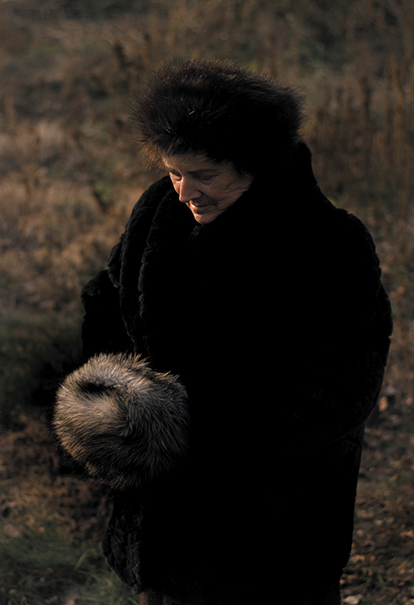
Paulina Niedzielska
Promieniami słońca oplotłeś mą duszę, trawą i ziemią otuliwszy swe ciało.
Byłeś – nie byłeś, a więc wciąż jesteś, a mi znowu, nieustannie – Ciebie zbyt mało.
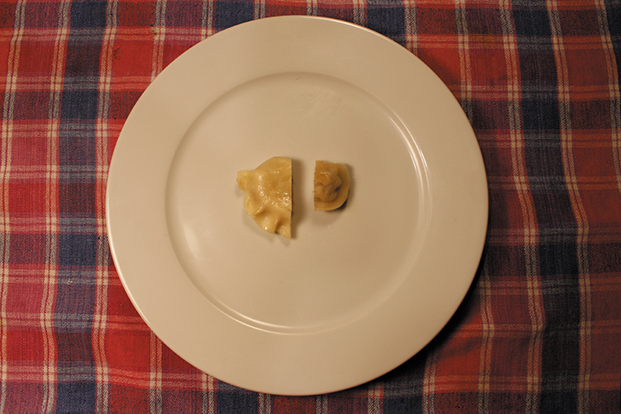
Jagoda Komorowska
Zdjęcie przedstawia relacje polsko-rosyjskie, wykorzystując proste nawiązanie do tradycyjnej kuchni: pierogi i pielmieni. Zestawienie ma pokazać, że różnice takie jak język czy sytuacja polityczna tylko pozornie stwarzają między nami bariery, jednak to podobieństwa są silną stroną tej relacji. Wspólna historia, tradycja i kultura, widoczne nawet w kuchni, pokazują, jak bardzo losy naszych narodów są splecione i wywodzą się z tej samej kultury oraz tradycji.
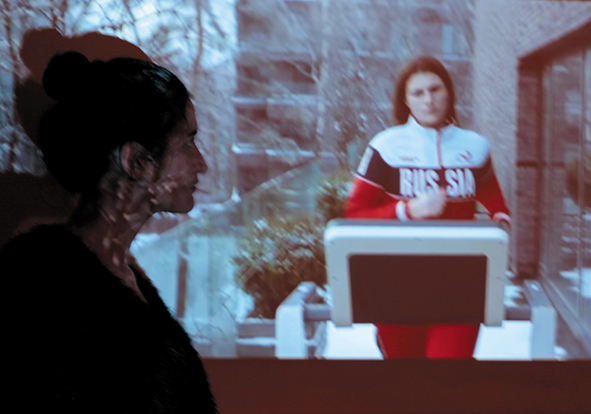
Monika Andryszek
W swojej pracy chciałam pokazać, że kultura rosyjska, chociażby kinematografia, jest obecna w kulturze polskiej. Dzięki tłumaczeniom język nie stanowi bariery i możemy obcować z wrażliwością naszych wschodnich sąsiadów. Użyłam projekcji kultowych rosyjskich filmów w przestrzeni mieszkania i wchodziłam w kadry, tym samym wchodząc w dialog z obrazem.
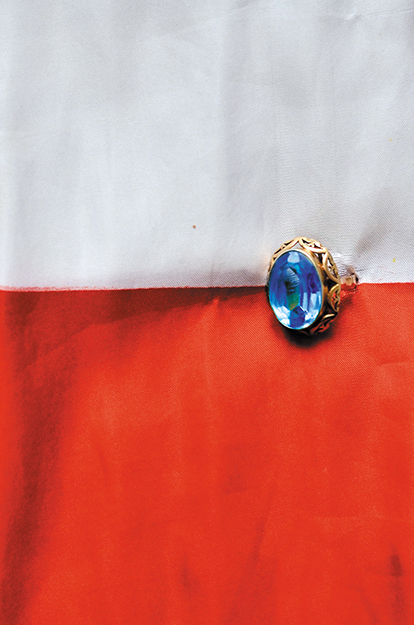
Małgorzata Bonas
Bez komentarza.
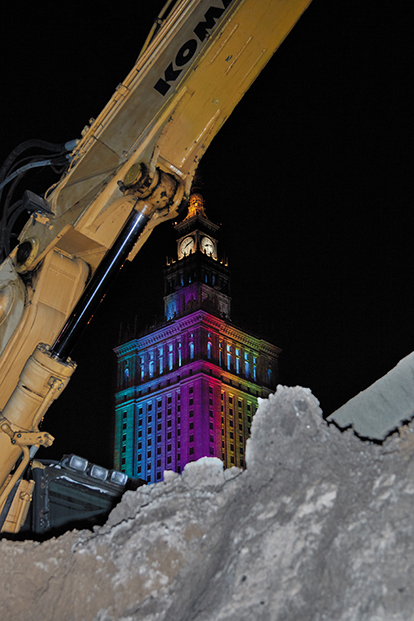
Dawid Grzelak
Zdjęcie ukazuje ciężki sprzęt ustawiony na tle Pałacu Kultury i Nauki, który oświetlony jest kolorami tęczy. W warstwie metaforycznej jest to symboliczne przedstawienie budowy stosunków polsko-rosyjskich. Fotografia odnosi się również do wciąż trudnej sytuacji osób środowiska LGBTQ+ w obydwu państwach oraz nikłej świadomości społecznej na ten temat.

Dobrosława Król
Zamysł fotografii zbudowany jest wokół jednego z częstszych skojarzeń dotyczących Polski oraz Rosji – kultury picia wódki. Czyste, jasne tło pozwala skupić uwagę na geście stuknięcia się kieliszków. Jest on symbolem pewnego braterstwa, więzi i zależności, jednak dominacja Rosji jest jasno zaznaczona przez poplamienie „polskiej ręki” rozlanym z kieliszka płynem w barwach flagi.
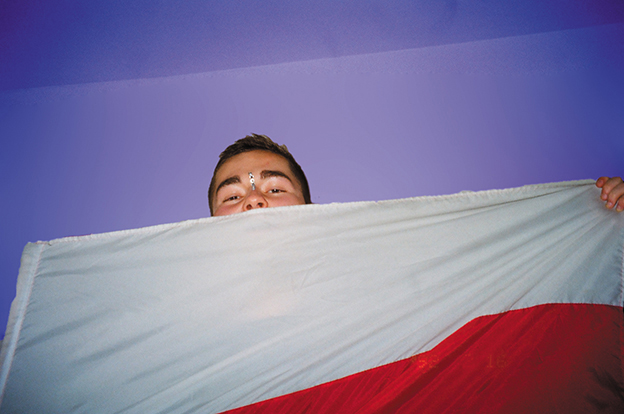
Olga Bronikowska
Bez komentarza.
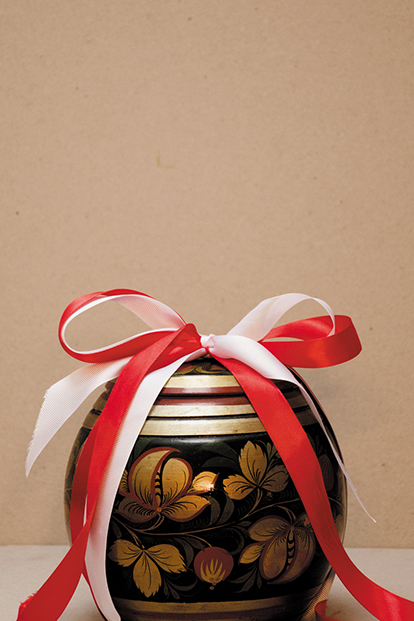
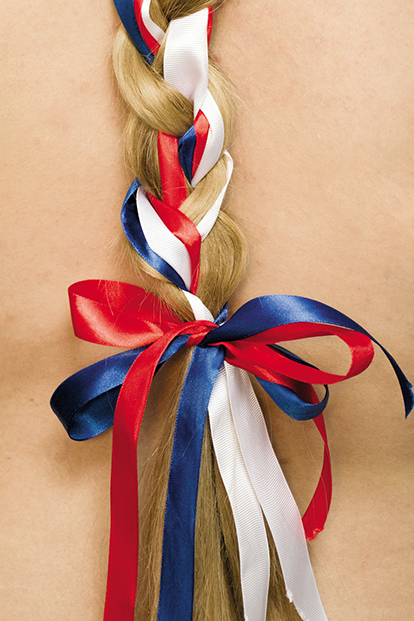
Anna Fabrycy
Projekt zrealizowałam w formie fotograficznego dyptyku. Przedstawia on relacje polsko-rosyjskie pod kątem przenikania się. Obrałam sobie bardziej kobiece spojrzenie na temat charakteru tych kultur. Oba zdjęcia łączy wstążka, która jest wspólnym elementem strojów ludowych w kolorach narodowych i oplata obiekty pochodzące z Polski i Rosji – szkatułkę na biżuterię oraz warkocz.

Anna Kordulewska
Moi Dziadkowie mieszkali w Rosji przez kilka lat. Tam też wychowywała się moja Mama. Dlatego ten kraj, jego język, kultura i duch są zawsze obecne w mojej rodzinie. Mimo że ja sama byłam w Rosji jedynie kilka razy, wyjeżdżając, za każdym razem czuję nostalgię. Zupełnie jakbym opuszczała dom. Tym właśnie jest dla mnie Rosja – drugim domem kryjącym się gdzieś między wersami codziennego życia, gdzieś po drugiej stronie lustra.
Na zdjęciu widzimy wyraz „dom” napisany na rozsypanej mące. Mąka nawiązuje do wspólnego gotowania, czynności, która mocno kojarzy się z domem i rodziną. Słowo „dom” zostało odbite w lustrze, tworząc ten sam napis, tym razem cyrylicą. Jest to odniesienie do mojego, opisanego wcześniej, stosunku do Rosji.
Ostatnim elementem zdjęcia jest spodeczek z herbatą, który stanowi dosłowną ilustrację rosyjskiego zwyczaju picia herbaty w ten właśnie sposób.
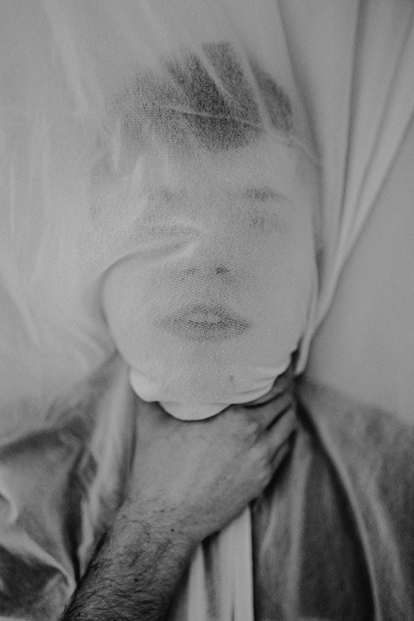
Maja Hylewicz
Zbrodnia i kara 2018
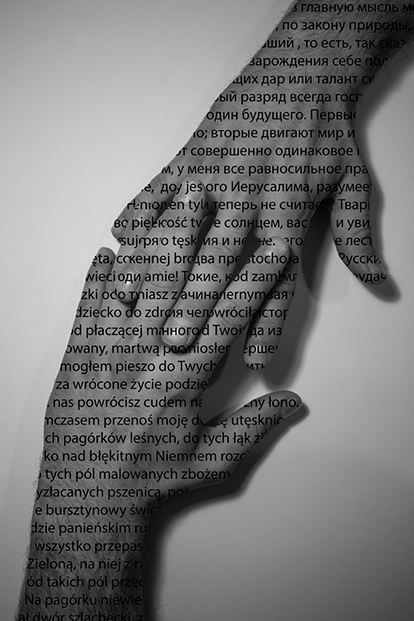
Natalia Szymala
W mojej fotografii chciałam pokazać bliskość obu państw – Polski i Rosji. Złączone ręce symbolizują połączenie obu narodów. Umieszczone na dłoniach teksty to cytaty z klasyki literatury. Po polsku zapisany jest fragment Pana Tadeusza Adama Mickiewicza, a po rosyjsku fragmenty Zbrodni i kary Fiodora Dostojewskiego. Mają one budzić skojarzenia z więzią, jaką może budować literatura.

Sylwia Rusinek
„Niech żyje nasz niezawodny przyjaciel Związek Radziecki! Niech żyje niezłomna, wieczysta przyjaźń polsko-radziecka!”1
1 „Życie Warszawy”, rok XII, nr 94 (3577) z 21 kwietnia 1955 r., s. 4.
